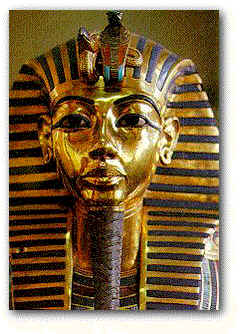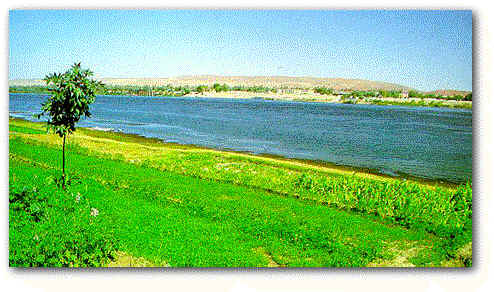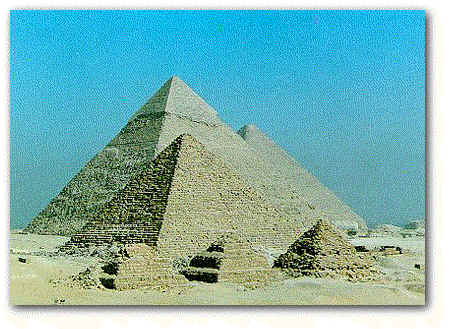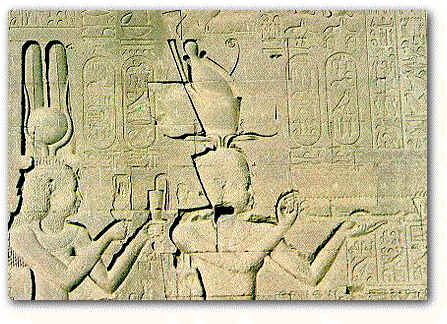| THE HISTORY OF ANCIENT EGYPT About 5,000 years ago, a remarkable way of life, or civilization, grew up along the banks of the Nile River in Egypt. It flourished for over 3,000 years, longer than most other civilizations in the world's history. Egypt is among the most influential of Islamic states. It lies in North Africa. This ancient country holds a history of over 6,000 years and has many exciting attractions for travelers. The Pyramids, the Sphinx, the tomb of young King Tut are just a few attractions that interest and excite people of all ages.
EGYPT'S CREATION Egyptian history begins around 3300 BC. This was when the Egyptians finally had enough symbols in their writing to record history. From 3100 BC inscriptions created a way for later Egyptians. It was also the time when the pharaoh, King Menes, created Egypt by uniting the two parts of Egypt, also known as Upper and Lower Egypt, into a single kingdom. He started Memphis in the north and Abydos in the south as his capital cities. A series of strong and able rulers established a well organized government. The calendar was introduced during this time and the sun-god Re was the most loved god-figure. Over time, authority began to disappear and Egypt was controlled by foreign princes. These rulers introduced the horses and chariots to Egypt. EGYPT REIGNS After many failed dynasties and deaths of great rulers, a time span of more than 400 years, power moved into the hands of priests and the empire declined. The dynasties became so weak, that Alexander the Great had no problem taking over Egypt. Although he did not spend much time in Egypt, his capital city of Alexandria, where he is believed to be buried, is to this day very successful. His empire was divided among his generals and this Greek dynasty ended with the reign of Cleopatra VII. She ruled jointly over Egypt with her son from their city of Alexandria in Lower Egypt, which became a world center of Greek culture. For over 300 years Greek-speaking pharaohs ruled Egypt, then Egypt became a province of Rome. A division of power resulted in the abandonment of Egypt. Many foreign countries came in and took over Egypt for short times. After many years of hard work and wars, Egypt finally became its own independent country with a President. THE NILE RIVER No other civilization in the time of the pharaohs could compete with Egypt's magnificent buildings, its wealth, or its long centuries of peace. To a large extent, this is because other civilizations did not have Egypt's main advantage -- its great river. For tens of thousands of years the focal point of Egyptian life has been the River Nile. Egypt is correctly said to be the gift of the Nile and Egypt's two most important areas are the Delta and the Nile Valley. The Nile Delta is the heartland of Egypt. The ancient Egyptians believed that the waters of the Nile came from a "mysterious heaven of plenty". All of Egypt depended on the Nile for water, food, and transportation. The need to maintain irrigation channels as well as the convenient transportation that the river provided were some of the reasons Egypt was the first country in the world to have a national government. The availability of this unlimited supply of water allowed the creation of a society which produced the wonders of ancient Egypt.
PHARAOHS Pharaoh simply means "the one who lives in the palace". Egyptians addressed their pharaoh as though he were a god with several forms. They thought he was more than human and addressed him with the names of several gods. The pharaoh's most godlike names were "son of Re" and "giver of life like Re". The Egyptians believed that no single name could express the greatness of their ruler. They also believed by serving the gods, the king helped the sun to rise every morning and helped the Nile to flood at the end of each summer. They believed that in return for the offerings of food and water that only the pharaoh could make, the gods would feed the souls of the Egyptians after death. The pharaoh's power was almighty and unquestioned. As a matter of fact, just touching the pharaoh's crown or scepter, even accidentally, carried the death penalty. The pharaoh's chief duty was to build and maintain temples to the gods. PYRAMIDS The buildings of Egypt that will impress you the most are probably the pyramids. All of them were built to contain the tombs of pharaohs. So far, 46 pyramids have been found. Others may still be discovered, lying in the ruins, under the desert sands. In the 27th century BC, the first pyramid was built and pyramids became the most popular way to bury royalty. It is the pyramids themselves that make Egyptian archeology so exciting. One reason why the pyramids were so fascinating was that they were the earliest buildings ever to be made by precisely cutting and putting together great blocks of stone. In stonework, Egypt led the world for more than 2,000 years. The Egyptians believed that a dead person's soul still needed the dead body and special objects buried with it in order to survive after death. They knew that the dry desert preserves things well, and they chose burial places there that are often well preserved today. Important Egyptians were wealthy enough to build magnificent tombs and furnish them richly with treasures, inscriptions, paintings, and statues. One of the most famous pyramids is the Great Pyramid of Khufu. It has 2,300,000 blocks and each block in the pyramid weighs 2.5 tons.
HIEROGLYPHIC INSCRIPTIONS Egyptians did not paint images to show what people were really like, instead, a picture was a kind of diagram. These diagrams were thought to have magical powers. To preserve the magical power of their art, the Egyptians believed they must copy exactly the style handed down through the ages. This meant that most artists painted in the same way, and the people they painted all looked the same. Tomb pictures were closely connected with Egypt's famous picture writing, or hieroglyphs, invented about 5,000 years ago. The Egyptians believed hieroglyphs were magical too, and they used them mostly in temples and tombs. All hieroglyphic symbols began as pictures standing for whole words. To write all the words they wanted to, however, the Egyptians needed to put some word pictures to work as signs for sounds.
Design, Layout and Graphic Art by Jimmy
Dunn, an InterCity Oz, Inc. Employee |
Thanks for letting me use this, Jimmy.





